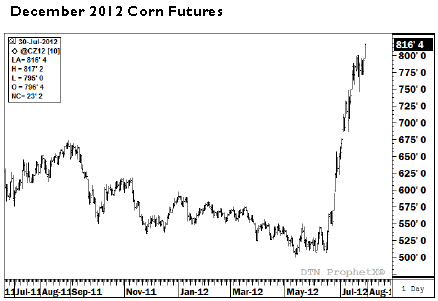



CME: Feed Crisis Deepens
US - Corn futures were sharply higher in overnight trading and as of the writing of this report, September corn futures were at an all time record high of $8.20/bushel, 22 cents higher than the previous close, write Steve Meyer and Len Steiner.Similarly, the benchmark December 2012 corn futures contract
was priced at $8.16/bushel, 22.75 cents higher than the previous
close. Limited rainfall overall the weekend and the prospect
of ongoing drought conditions across much of the US corn belt and
the Greta Plains has caused farmers and market analysts alike to
lower their expectations about the potential of the current corn
and soybean crops.
Some estimates now openly pegging the expected
average yield of the US corn crop below 130 bushels per
acre with one well followed firm indicating yields could be in the
low 120s. Also dramatic will be the impact of the drought on the
number of harvested acres. As we noted in our reports in early
July, previous drought impacts have significantly reduced the
number of acres harvested for grain.
In addition to lower yields,
we could a decline of about 3 million harvested acres from previous
estimates. Yields in the 120s and lower harvested acres would
imply even more significant reductions in US feed use in order to
ration the available supply. A big wild card at this point is the
position of the EPA with regard to the ethanol mandate. At what
point does the impact of high feed costs on livestock producers becomes
high enough to warrant a temporary waiver of the mandate?
In some areas livestock production has been tenuous enough
that the current feed crisis could lead to thousands of family farms
getting out of business. This kind of structural change would have
long lasting repercussions for US meat production going forward.
It is a political decision that becomes even more complicated in a
presidential election year.


Meat supply update
Combined red meat and poultry production for the week ending
28 July was 1.703 billion pounds, 0.7 per cent higher than a year ago.
Beef supplies remain limited but some of the dramatic reductions
in slaughter numbers have been offset by heavier cattle coming to
market. Dressed cattle weights are currently some 2.5 per cent above
year ago levels.
As packers slow down slaughter in an effort to
bring a margin back in their business, cattle on feed are tacking on
more pounds, with steer and heifer weights sharply higher than a year go. Hog weights also quoted by USDA some 2 per cent above year
ago levels but that number appears to be overstated and will
likely be revised lower. Full supply details on page 2 (please see link below).
Further ReadingYou can view the full report by clicking here. |








